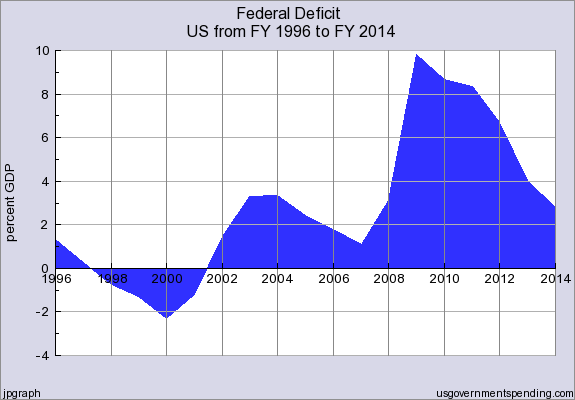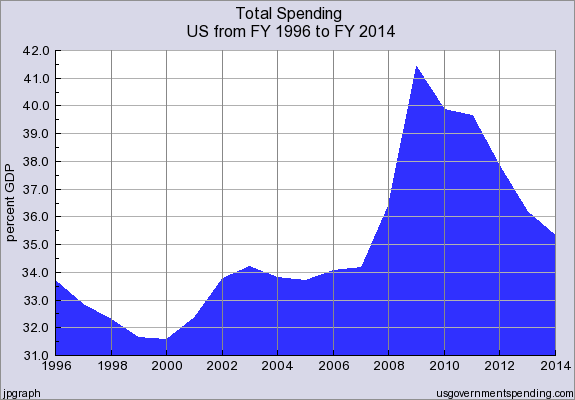Paul Krugman and many others on the left have claimed that “austerity” policies are the reason for the stagnant recovery from the recession that occurred from December 2007 through June 2009. One can only wonder how they can be so delusional as to call U.S. fiscal policy “austerity.”
You keep using that word. I do not think it means what you think it means.
– Inigo Montoya (The Princess Bride)
The term “austerity” conjures up ideas of being frugal, doing with less, and spending little, which is a far cry from what happened in the U.S. (and globally). You wouldn’t know it from listening to Krugman and Democrats repeatedly and hysterically criticize Republicans for opposing more spending increases, but the truth is that spending skyrocketed. The chart below shows what happened to total federal, state, and local government spending beginning with the recession in 2007.
Is this what is supposed to pass for “austerity”? I can only imagine what it would take to instead warrant the term “profligate”!
Keep in mind that what looks like a sharp decrease in government spending in recent years was only relative to the size of the economy. As you can see below, absolute spending was relatively flat and is much higher than before the recession.

Spending didn’t decrease so much as the size of the economy began to catch up with the massive increase in spending that had occurred. To put the current level of spending in better perspective, let’s go back a little further.

Even after the recent (relative) decrease in total government spending, it is still higher than pretty much every year in peacetime in this country’s history. That’s austerity?
Spending is also much higher than during the New Deal that Democrats & other Keynesians would have us believe began to lift us out of the Great Depression. Interestingly, pretty much all of the growth in government spending occurred before FDR even took office in March 1933.

The surge in spending actually occurred from 1929 to 1933. Coincidentally, the extremely sharp recession that began the Great Depression occurred from August 1929 through March 1933.
Another interesting fact is that there was a very sharp recession from January 1920 through July 1921. Governments responded by slashing spending, and we subsequently entered the Roaring 20s. We recovered from a sharp contraction through a policy of true austerity. Democrats/Keynesians are very careful to ignore these facts because they both contradict the idea that the best way to recover from a sharp contraction is by increasing government spending massively.
What about deficits? Again, there is nothing “austere” about our budget deficits. I didn’t have access to state and local budget deficit numbers (which have obviously been high), but look at the massive federal deficits we began to run.

The ludicrous claim of “austerity” becomes even more absurd when we go back farther.

Except for World War I and World War II, we haven’t come close to running such massive deficits before. Austerity? Really?
Will we be fooled again?
The repeated failure of massive spending increases to stimulate the economy throughout history and around the world hasn’t dissuaded Keynesians from their delusional thinking. In fact, I have noticed a surge in articles by Keynesians doubling down on their flawed theories and insisting that “austerity” is the problem.
Get ready for a renewed War on Common Sense.



{ 2 comments… read them below or add one }
If you put Government Expenditures per Capita on the y axis instead of percent GDP you will see what people are talking about when they use the term austerity.
Ronald, government expenditures per capita just further proves my point.
See this post:
http://www.madcapitalist.com/tax-increases-wont-eliminate-our-budget-deficits/
Per capita federal spending (in inflation-adjusted, constant FY 2009 dollars) increased from about $7,963 in FY 2000 to about $10,577 in FY 2014. Now, you could *try* to argue that $10,577 is austerity because it is down from a high of $11,548 in FY 2009, but this is absurd. The $10,577 per capita is still 13% higher than the pre-recession FY 2007 spending of $9,383, and it is still 33% higher than FY 2000.
And remember that this is all in inflation-adjusted terms.